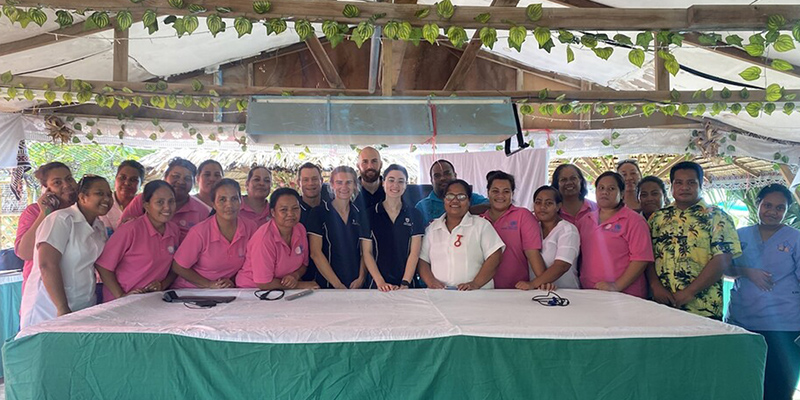Podiatry team visits Kiribati to kickstart diabetic footcare
By Annabel Mansfield
 COMMUNITY UniSA podiatry team with Kiribati health professionals.
COMMUNITY UniSA podiatry team with Kiribati health professionals.When you have diabetes, your feet are front and centre of your care. That’s because diabetes can damage the nerves in your feet, leading to poor blood circulation, foot ulcers and, in serious cases, lower limb amputations.
People in low- and middle-income countries have a much higher risk of health complications as they do not have access to basic technologies and health care to help them manage their disease. They also have a higher risk of death.
Earlier this year, UniSA Program Director for Podiatry Dr Ryan Causby, together with three final-year students and a third-year student, visited the Republic of Kiribati (pronounced Kiribus) to provide some much-needed aid and advice on diabetic foot care.
“Kiribati has an extremely high level of diabetes, with up to 29% of the population (aged 25-64) diagnosed with the condition,” Dr Causby says.
“It also has a ‘perfect storm’ of tropical conditions – poor footwear, poor access to healthy food or clean water, inadequate access to medications and healthcare, as well as high levels of poverty – which means that many people develop foot wounds associated with diabetes.
“Many people find these difficult to prevent from becoming infected, and the awful reality is that most people with foot wounds end up with a lower limb amputation.”
Thanks to some residual New Colombo Plan funding (an initiative of the Australian Government that aims to build Australia’s relationships in the Indo-Pacific by supporting Australian undergraduates to undertake study and internships in the region), a UniSA podiatry group was able to visit Kiribati for two weeks to work in the hospital and health care clinic.
The students worked alongside local nursing and orthotic and prosthetic staff on the wards and outpatient clinics to manage chronic wounds and amputation sites . They also provided a workshop on pressure offloading.
“Exposing our podiatry students to things they would not otherwise see, provides an incredible opportunity for them to learn and practice their skills,” Dr Causby says.
“Due to the environment, students were unable to rely on expensive dressings, footwear or ‘moonboots’, so they had to go back to primary health care principles and get creative.
“The trip also helped upskill to local health workers. By sharing our knowledge and health skills with the local community, we were able to empower them to improve foot ulcer management and prevent diabetic foot amputation in a sustainable way.”
Other Stories
- Time off means weight on for Aussie kids
- $10m precision engineering centre for defence manufacturing opens at Mawson Lakes
- Many people willing to sacrifice salary to work from home
- ‘I can see the characters’: how reading aloud to patients can break through ‘cancer fog’
- From the Vice Chancellor: Looking forward while reflecting on a stellar year
- Achievements and Announcements
- 2023 Wrapped: Watch highlights from the year that was
- Crows Captain prepares to kick goals in the classroom
- UniSA Online students set for overseas immersions thanks to New Colombo Plan Scholarships
- Podiatry team visits Kiribati to kickstart diabetic footcare
- In Pictures: Unstoppable Awards + Staff Service Awards
- The latest books from UniSA researchers




